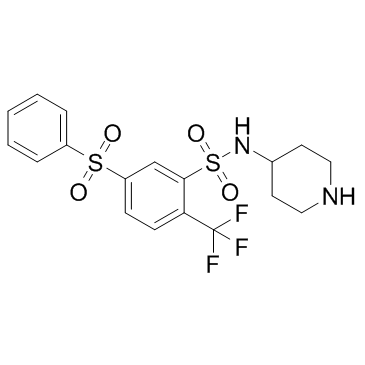| Description |
WAY 316606 is an inhibitor of the secreted protein sFRP-1, an endogenous antagonist of the secreted glycoprotein Wnt. The affinity of WAY-316606 for sFRP-1 is determined using the FP binding assay with IC50 of 0.5 μM.
|
| Related Catalog |
|
| Target |
IC50: 0.5 μM (sFRP-1)[1]
|
| In Vitro |
The EC50 of WAY-316606 for Wnt-Luciferase Activity from U2-OS Cells is 0.65 μM[1]. WAY-316606 binds to secreted frizzled-related protein (sFRP)-1 inhibitor with a KD of 0.08 μM and inhibits sFRP-1 with an EC50 of 0.65 μM. WAY-316606 also binds to sFRP-2, albeit over 10 times weaker with a KD of 1 μM. Using a fluorescence polarization binding assay that employs a fluorescent probe compound and purified human sFRP-1 protein in a competitive-binding format, the IC50 for WAY-316606 is 0.5 μM[2].
|
| In Vivo |
WAY-316606 increases bone formation when tested in a neonatal murine calvarial assay. WAY-316606 increases total bone area up to 60% in a dose-dependent manner with an EC50 of about 1 nM. WAY-316606 has good aqueous solubility, moderate to low inhibition of cytochrome p450 isozymes (3A4, 2D6, 2C9) and good stability in rat and human liver microsomes (t1/2>60 min in each species). In female Sprague-Dawley rats, WAY-316606 exhibits high plasma clearance (77 mL/min/kg, greater than hepatic blood flow) following a single intravenous bolus dose (2 mg/kg), which results in a rapid decline of drug exposure in the plasma despite the route of administration[2].
|
| Kinase Assay |
WAY-316606 binding to purified sFRP is determined by spectroscopy methods. The sFRP-1 or -2 stock solutions are diluted to 1 μM in a buffered solution and the initial fluorescence is measured. Increasing concentrations of WAY-316606 (0 to 50 μM) are added to the protein in the cuvette and incubated for 5 min prior to assessing fluorescence intensity using a Fluoromax-2 fluorometer. In control experiments, the DMSO (vehicle control)-matched buffer solution is used. Fluorescence spectra are scanned in the ratio mode (S/R, signal/reference) to compensate for variations in lamp output as a function of wavelength. Fluorescence changes are fitted to a quadratic equation to obtain apparent dissociation constants[2].
|
| Cell Assay |
U2OS bone cells are infected with recombinant adenovirus 5 (Ad5)−WNT3 at a multiplicity of infection (MOI) of 2, followed by infection with Ad5-sFRP-1 and Ad5-16xTCF-luciferase, each at an MOI of 10. Four hours after infection, the cells are frozen in sterile cryogenic vials at a cell density of 9×106 cells/mL and stored in a −150°C freezer. For the assay, a vial of frozen cells is thawed, and the cells are resuspended in plating medium [phenol red-free RPMI 1640 medium containing 5% fetal calf serum, 2 mM GlutaMAX-l, and 1% (v/v) penicillin-streptomycin] to a final cell density of 1.5×105 cells/mL. The resuspended cells are then plated in 96-well tissue culture treated plates at a volume of 100 μL of cell suspension/well (i.e., 1.5×104 cells/well). The plates are incubated at 37°C inside a 5% CO2/ 95% humidified air incubator for 5 h or until the cells have attached and started to spread. Prior to the addition of WAY-316606, the medium is replaced with 50 μL/well of phenol red-free RPMI 1640 containing 10% fetal calf serum, 2 mM GlutaMAX-l, and 1% (v/v) penicillin-streptomycin. WAY-316606, or vehicle (typically DMSO), diluted in phenol red-free RPMI 1640 containing 2 mM GlutaMAX-l, and l % (v/v) penicillin-streptomycin are then added to the wells in replicates of 4 wells/dilution and the plates are incubated at 37°C overnight. Dose−response experiments are performed with the compounds in 2-fold serial dilutions from 10000−4.9 nM. After the overnight incubation, the cells are washed twice with 150 uL/well of PBS w/o calcium or magnesium and lysed with 50 μL/well of 1× cell culture lysis reagent on a shaker at room temperature for 30 min. Aliquots of the cell lysates (30 μL) are transferred to 96-well luminometer plates, and the luciferase activity is measured in a MicroLumat PLUS luminometer using 100 μL/well of luciferase substrate.
|
| References |
[1]. Moore, WJ, et al. Modulation of Wnt Signaling Through Inhibition of Secreted Frizzled-Related Protein I (sFRP-1) with N-Substituted Piperidinyl Diphenylsulfonyl Sulfonamides. Journal of Medicinal Chemistry (2009), 52(1), 105-116. [2]. Bodine PV, et al. A small molecule inhibitor of the Wnt antagonist secreted frizzled-related protein-1 stimulates bone formation. Bone. 2009 Jun;44(6):1063-8.
|
